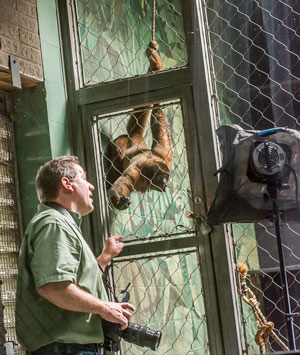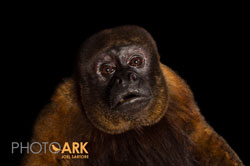 by Kyle Shepherd
by Kyle Shepherd
Our woolly monkeys, Henry and Tomas, got star treatment this past June when renowned National Geographic photographer Joel Sartore visited Louisville Zoo to photograph the pair for his Photo Ark project. Henry and Tomas are renowned themselves being the only two woolly monkeys left in a North American zoo. Their precarious status is the primary motivation for Sartore’s desire to document them for this fascinating and important project. Sartore also photographed snakes and other herps while at our Zoo.
The goal of Sartore’s Photo Ark project is to show the world what is at stake for so many endangered species and to inspire people to save them while there’s still time. For many of the Earth’s most amazing creatures, time is running out. Half of the world’s plant and animal species will soon be threatened with extinction.
 Sartore has spent the last nine years photographing some of the world’s most precious species. For logistical reasons, he has chosen to work with zoos internationally to identify key members of threatened species and stage opportunities to photograph them, not an easy feat. He estimates he’s photographed 3,700 species in his quest to document the 10,000 -12,000 species in managed systems, a very ambitious project to say the least. He anticipates this will be a 20-plus year project.
Sartore has spent the last nine years photographing some of the world’s most precious species. For logistical reasons, he has chosen to work with zoos internationally to identify key members of threatened species and stage opportunities to photograph them, not an easy feat. He estimates he’s photographed 3,700 species in his quest to document the 10,000 -12,000 species in managed systems, a very ambitious project to say the least. He anticipates this will be a 20-plus year project.
What would make someone devote 20 years to one highly concentrated project? Sartore explains that “These animals are beautiful, they are intelligent and they deserve the right to exist.” His work as a National Geographic photographer has taken him all over the world, and he’s seen firsthand the devastation of our planet’s habitats and wildlife. “Every year I see more habitat lost, more species consumed for food, medicine or simply for decoration.”
We in the zoo world are privileged to care for some of the planet’s most exotic creatures; we also have the chance to help families build memorable experiences in the context of a park inhabited by these rare and threatened species. But perhaps more importantly, we have a special obligation to illuminate the need for conservation, helping our guests understand how to be better stewards of our planet’s resources. We hope to work together to halt or slow the destruction of our animal ambassadors and what remains of their natural habitats. As Sartore photographs the snakes behind the scenes at the HerpAquarium, he shares a hopeful observation with the few of us gathered around: “You just can’t help but want to do something.” We grasp the importance of his mission and are reminded of a quote by environmentalist Baba Dioum who said, “In the end, we will conserve only what we love, we will love only what we understand, and we will understand only what we are taught.”
Originally published in Trunkline Magazine, Sept. 2014.
